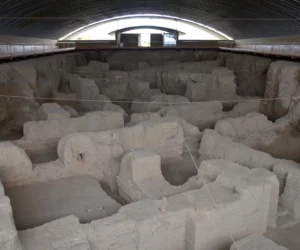Introduction to Ecbatana Ecbatana, known in Old Persian as Hagmatāna, meaning “the place of gathering,” served as the ancient capital of the Median Empire. It was the first capital of Iran and later became the summer capital for both the Achaemenid and Parthian Empires. The city also played a significant role during the Seleucid and…
Median Kingdom
The Median Kingdom, an ancient Iranian state, emerged in the late 7th century BC and played a pivotal role in the transformation of the Near East. Situated in the western and northwestern parts of present-day Iran, the Medes were part of the Iranian peoples who migrated into the region around 1000 BC. The Median civilization flourished between 678-549 BC, marking a period of significant development in the history of Iran and the wider region.
The foundation of the Median Kingdom is often attributed to Deioces (reigned 728-675 BC), who is credited with uniting the Median tribes and establishing the capital at Ecbatana (modern-day Hamadan). His efforts laid the groundwork for the emergence of a centralized state. The kingdom reached its zenith under Cyaxares (reigned 625-585 BC), who reorganized the Median army and led successful campaigns against Assyria, culminating in the fall of Nineveh in 612 BC. This victory significantly weakened the Assyrian Empire, leading to its eventual collapse and marking a major moment in Near Eastern history.
The Medes are noted for their participation in the Battle of Halys in 585 BC, which ended in a draw with the Lydians. This battle is historically significant as it led to the negotiation of a peace treaty, reputedly facilitated by the solar eclipse that occurred during the battle, an event predicted by the Greek philosopher Thales. This treaty delineated the borders between the Median and Lydian empires and was sealed by a royal marriage, demonstrating the diplomatic acumen of the Medes.
Religiously, the Medes practiced a form of ancient Iranian religion that was closely related to the early Zoroastrian faith. They worshipped a pantheon of gods and held fire in high esteem, a practice that would later become central to Zoroastrianism. The religion influenced various aspects of Median life, from politics to daily routines, embedding a sense of piety and respect for the divine order in the society.
Socially, the Median society was structured around tribal lines, with a significant emphasis on kinship and clan affiliations. This tribal organization played a crucial role in the military and administrative frameworks of the kingdom. Daily life in the Median Kingdom would have revolved around agriculture, animal husbandry, and trade, with Ecbatana serving as a vibrant cultural and commercial hub. The city was famed for its fortifications and luxurious palaces, indicative of the wealth and sophistication of Median society.
The fall of the Median Kingdom came in 549 BC when Cyrus the Great of Persia, in a swift and decisive campaign, overthrew Astyages, the last Median king. This conquest marked the end of the Median Kingdom and the rise of the Persian Achaemenid Empire, which would go on to become one of the largest empires in ancient history. Despite their defeat, the Medes were integrated into the new empire, with many serving in high-ranking positions within the Persian administration and military.
The legacy of the Median Kingdom is evident in the cultural and political developments that followed its incorporation into the Persian Empire. The Medes contributed significantly to the administrative and military systems of the Achaemenid Empire, influencing the governance of a vast territory that stretched from the Indus Valley to the Aegean Sea. Their influence is a testament to the sophistication and power of the Median civilization, which played a crucial role in shaping the history of the Near East.
In conclusion, the Median Kingdom was a formidable power in the ancient Near East, known for its military prowess, sophisticated society, and significant contributions to the cultural and political landscape of the region. From its tribal beginnings to its integration into the Persian Empire, the Medes left an indelible mark on the history of Iran and the wider world.

Tepe Nush-i Jan
Tepe Nush-i Jan is an archaeological site located in the Malayer valley, near the town of Malayer in western Iran. The site, which dates back to the Median period, around the first half of the first millennium BCE, consists of the remains of a fortified complex, including a temple, a large columned hall, and residential quarters. Excavations at Tepe Nush-i Jan have revealed significant artifacts and structures that provide insights into the religious practices, social organization, and architectural styles of the Median civilization.

